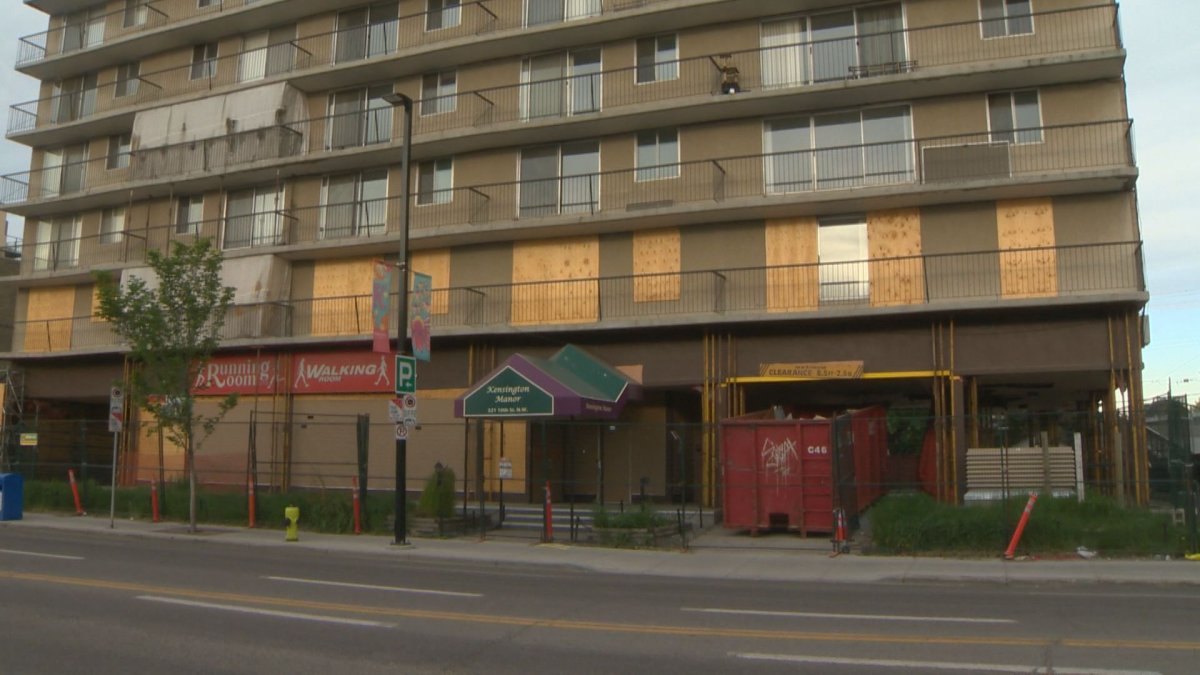Calgary’s vacant and troublesome Kensington Manor won’t be going anywhere soon — the city said Wednesday it’s currently preparing for asbestos removal, which is expected to start in December.

It’s been nearly two years since the residents of the Kensington apartment complex were evacuated in a hurry after the Calgary Fire Department said it was at risk of “possible imminent collapse.” The 125 residents had only 15 minutes to gather their belongings from the 57 units in the building, which has sat vacant ever since.
In January 2019, the city took over responsibility for Kensington Manor after the owner stopped co-operating with city officials. A committee voted in June to demolish the condemned structure, citing several safety concerns including keeping people out and the risk of fire.
City officials met with Kensington community members, the Business Revitalization Zone and owners of neighbouring properties on Tuesday night to “share the high-level construction schedule” and answer questions, according to city spokesperson Sherri Zinkefoose.
“It is approximately a 3.5-month process, and the demolition of the building will commence once asbestos removal is complete,” Zinkefoose said.
Zinkefoose did not say what impact the asbestos removal process might have on neighbouring businesses or residences, or how traffic could be impacted along the busy 10 Street N.W. throughout the project.
The city also didn’t have a cost estimate for the asbestos removal or the demolition as a whole.

According to Cody Larson, CEO of Remediclean — which does various environmental services like abatement, restoration and demolition — removing asbestos from a building of that size and age is a large undertaking.
Larson said the process starts with a hazardous materials building assessment to determine what contaminated items may be inside, which is part of the demolition permit. Then, officials can proceed with planning to remove those items and any other contaminates the demolition survey might find.
Once the contractor has been secured to take care of the asbestos, work would get underway to contain the building or room if the asbestos problem is on a smaller scale, according to Occupational Health and Safety guidelines. Larson said the city’s 3.5-month timeline for Kensington Manor falls within general time estimates.
What is asbestos found in?
Larson said the asbestos could be found in anything such as drywall, plaster, flooring, window caulking, stucco on ceilings, mechanical system insulation and boiler components, meaning crews could find a wide variety of things that need to be taken out of the Kensington Manor complex.
“There’s not a whole lot of education that is really given to the public. You’re almost out to kind of fend for yourself and look for yourself, especially as a homeowner or property owner with what could or couldn’t contain asbestos before you purchase a property,” Larson said.
Larson said neighbouring residences and businesses shouldn’t see negative impacts of the asbestos removal at Kensington Manor as long as the process is done correctly and the contractor takes the right precautions.
“The work is done in a way that the materials are contained inside negative pressure enclosures, basically meaning the air comes in through HEPA filters and does not escape the other way. It’s all pumped through filter systems that filter the air and allow for the airborne dust inside to be contained,” he said.
“There’s very, very little risk, like I said, as long as the procedures are being followed.”
What are the safety steps ahead of time?
Crews starting an asbestos removal job have to file a notification with OHS 72 hours before the planned start of the work so officials can review the procedures, Larson said.
OHS will do inspections on asbestos removal projects like Kensington Manor both before and during the operations.
While Larson couldn’t comment on exactly what is required to clear the vacant apartment building of asbestos, he said preparations could mean sealing all the openings with polyethylene, installing negative pressure systems and decontaminating structures like showers for employees. Or it could be as minor as putting up privacy barriers and equipping workers with personal protective equipment to shield them from the dust fibres.
Larson said depending on the materials containing the asbestos, the dust level can vary. Items like mechanical insulation are considered highly friable because you can pick it up and crush it, creating dust. The procedures and tools being used can also change the risk level of the process.
“If you’re using the wrong tool, like if you’re using a grinder to remove asbestos from something, that grinder is going to generate very high amounts of dust, whereas using hand-removal tools and wet methods will create a very low amount of asbestos fibres in the air,” Larson said.
As the remediation work is underway, air removed from the building should be tested regularly, Larson said. Once it’s done, a consultant has to do visual and air quality assessments and get clearance to prove the work has been done properly, with no fibres left in the air.
He said asbestos removal can be very costly work as it’s very complex, but doing it properly is essential to the health and safety of the workers involved and the public.
The city is footing the bill for the demolition of Kensington Manor but hopes to recoup some of those costs by adding it to the owner’s property tax bill.


Comments